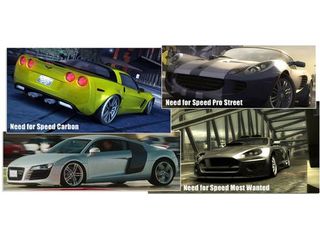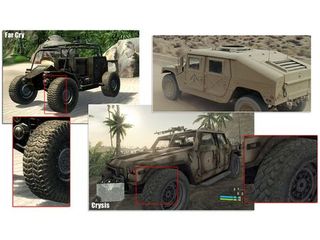Reality Check: 3D Graphics Take On Hollywood
Vehicles
Realistic race games used to be limited by computing power. Tricks like a reduced environment, blurred textures, and limited visibility caused by fog were used. In recent years these tricks have hardly been necessary, as the 3D power of PC systems was sufficient to represent the street of the race track in as much detail as the cars themselves. Now the PC is busy with speed effects, reflections, and clever damage models. It’s hardly surprising that the graphic designers tend to concentrate more on the cars, which are looking more realistic than ever.



More about fire, water, Hollywood monsters, special effects, and physics willbe found in the second part of this article.
Stay on the Cutting Edge
Join the experts who read Tom's Hardware for the inside track on enthusiast PC tech news — and have for over 25 years. We'll send breaking news and in-depth reviews of CPUs, GPUs, AI, maker hardware and more straight to your inbox.
-
jimmysmitty Of course it can always get better. it just depends on how much of the power available to them the game designers want to use. For PC its harder though since they want the most sales and want to go from low to high end.Reply
Introducing MT in games would boost FPS allowing more and better eye candy.
A good example is L4D from VALVe. Source is a 4 year old engine but some of the graphics in that game are close to Crysis which is amazing to be honest since Crysis was made with a much newer engine.
It is also rumored to include MT capabilities. Will have to see.
Once game designers stop worrying as much they will finalyl make better looking games. As you can see from Far Cry 2 though the PC looks to have much superior graphics for it. The 360 version looks a bit bland where as the PC version looks nice and gritty. -
V3NOM yaya dx 11... cant wait to spend another $100 on another OS and $500 for a new graphics setup which will then be incompatible with something therefore resulting in a whole new $1000+ system. who wouldn't want to?Reply -
safcmanfr V3NOMyaya dx 11... cant wait to spend another $100 on another OS and $500 for a new graphics setup which will then be incompatible with something therefore resulting in a whole new $1000+ system. who wouldn't want to?Reply
Shows how much you read up about DX11. It will be compatible on Vista and Windows 7 - so no need to update your OS. Unless you still use XP, which is your choice and you just need to live with the consequences.
Yes you will need a new GPU - but if you are a serious gamer you probably buy one of those every 9-12 months anyway. and $500? for the very top end perhaps - but why not go for the equivalent of the 4870 when dx11 comes out - which is $250? -
enewmen Thanks for the article.Reply
I hope to see realistic/possible samples of future(1-4 years) screenshots in another article. -
As a researcher in the field of computer graphics, I can safely say that we haven't seen the end of it. Yes, a lot of hope has to be put on faster hardware. And lets face it - light is a tricky business...you do not think about it, but the complexity of the processes involved that enable you your eyesight is enormous.Reply
Yet, every now and then a new algorithm is developed, which introduces more accuracy and less approximations, which runs faster and more optimal. It is not yet sure which idea will prevale (ray tracing or raster or something else), but it is sure that visible pixelization, coarse models, unrealistic lighting etc are going to be pretty much the past. When? Nobody can honestly answer this question...lets wait and see. -
dobby safcmanfrReply
actually it get better still, acording to all currently known info, direct3D 11 will be perfectly backward compatible with both vista and win7, but also the infrastructure of DX10 and DX10.1 GPU's will be able to support directX 11.
see: http://en.wikipedia.org/wiki/DirectX#Direct3D_11
^and yes i do know that wiki isnt the great source, but it is as good as any.
although the way the article is worded, it is made to sound as though some of the more subtle effect would require an upgrade. however the import part is GPGPU support accross both nvidia and ATi, and multithreading which will be supported.
-
caamsa ReplyAs a researcher in the field of computer graphics, I can safely say that we haven't seen the end of it. Yes, a lot of hope has to be put on faster hardware. And lets face it - light is a tricky business...you do not think about it, but the complexity of the processes involved that enable you your eyesight is enormous.
Well it took evolution billions of years to perfect the human eye so I think we can cut you programmers a break ;-) so far most of the new games look great.
I enjoy good looking games but the games need to have some substance to them as well. No one wants to play a crappy game no matter how good it looks.
-
WyomingKnott Either most of the illustrations also include a real photograph, or there is some incredible quality out there. In the illustration "Targeted use of light sources lighting up a grid structure," is the upper-right image, an outside view of a window with bars, a real photo? If not, let me know what game it is from and I will buy it.Reply -
neiroatopelcc Even with all those effects I'm still marvelled by the lack of realistic structures. I do have a gaming rig with sufficient power to play crysis and what not, but still I can't find a game where walls don't look unnaturally sharp edged.Reply
No matter how much soft shadow, af or aa is applied, it still manages to look like a building is simply 4 completely straight walls. Even when you blow something up in the newest crysis game you'll notice that a building is made up of incredibly straight sheets of wood or metal. Sure they've come a long way with foilage and stuff, but hollywood knows a great deal more about realistic structures than game developers seem to do.
Most Popular

